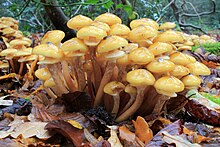| Armillaria mellea | |
|---|---|

| |
| Scientific classification | |
| Domain: | Eukaryota |
| Kingdom: | Fungi |
| Division: | Basidiomycota |
| Class: | Agaricomycetes |
| Order: | Agaricales |
| Family: | Physalacriaceae |
| Genus: | Armillaria |
| Species: | A. mellea
|
| Binomial name | |
| Armillaria mellea | |
| Synonyms[1] | |
| |
| Armillaria mellea | |
|---|---|
| Gills on hymenium | |
| Cap is convex or flat | |
| Hymenium is adnate or subdecurrent | |
| Stipe has a ring | |
| Spore print is white | |
| Ecology is parasitic | |
| Edibility is edible or can cause allergic reactions | |
Armillaria mellea, commonly known as honey fungus, is an edible basidiomycete fungus in the genus Armillaria. It is a plant pathogen and part of a cryptic species complex of closely related and morphologically similar species. It causes Armillaria root rot in many plant species and produces mushrooms around the base of trees it has infected. The symptoms of infection appear in the crowns of infected trees as discoloured foliage, reduced growth, dieback of the branches and death. The mushrooms are edible but some people may be intolerant to them. This species is capable of producing light via bioluminescence in its mycelium.
Armillaria mellea is widely distributed in temperate regions of the Northern Hemisphere. The fruit body or mushroom, commonly known as stump mushroom, stumpie, honey mushroom, pipinky or pinky, grows typically on hardwoods but may be found around and on other living and dead wood or in open areas.